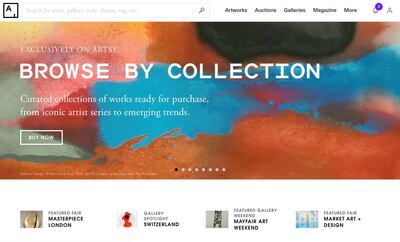Museums and galleries are having a digital moment as online competitions and exhibition walk-throughs spring up across the virtual landscape.
With art spaces closed and fairs cancelled due to the coronavirus pandemic, there was only one place left for galleries to go: the internet.
This is something Artsy chief executive Mike Steib is quick to point out. “Galleries connect with collectors in their physical spaces, at art fairs and online. Unfortunately, for some period of time, those first two channels are limited or completely closed, and so we are finding that a lot of galleries are leaning in harder to these online opportunities.”
Artsy, an online platform for buying and selling art, has been around for a decade. Among its competitors are websites such as ArtNet, Saatchi Art and Artsper.
Their business models operate similarly, through paid memberships and consignments from collectors. Artsy charges galleries a fee to upload works on the platform for buyers to purchase. The company also draws a percentage from the sales. According to Artsy, pricing models vary for each gallery’s size, artist roster and the level of promotion on the website.
After closures caused by the pandemic, the website has seen its traffic go up by 20 per cent, with galleries uploading nearly a third more artworks for sale in the last two weeks of March.
But is this a temporary, reactionary business measure or does it signal a more permanent shift towards e-commerce for the art market?
The latter would serve websites such as Artsy well. Numbers indicate that collectors are becoming more comfortable buying art online: the volume of sales on the platform grew by up to 150 per cent over the past two years. Steib notes that traffic on the website from the Middle East and North Africa has increased by 30 per cent in the last year.
For him, this moment marks a chance for galleries to capture new audiences. “It’s an amazing opportunity for the entire industry, because we have under-served the younger and more digitally-savvy collectors who have this expectation of secure, high transparency, easy online shopping.”
Steib is also banking on the emergence of young affluent collectors. “That is the generation that is inhering $15 trillion [Dh55tn] over the next 10 years. It’s the generation that is going to provide for the art world for decades to come,” he adds.
The Amazon of art?
With more than a million artworks on the platform, it seems Artsy has its sights on becoming the Amazon for the art market, down to its algorithmically tailored shopping experience. A curatorial team also develops themed collections regularly, including the recent Women Artists from the Middle East collection, featuring artists such as Etel Adnan, Hayv Kahraman, Diana Al Hadid and Mona Hatoum.
Part of the company’s set of goals is to create a more transparent market, where buyers can compare prices and shop around much like they would on other e-commerce platforms. Steib acknowledges, however, that digital will not replace face-to-face purchases altogether.
“There will always be an offline component to art-buying. The problem with art transactions in the physical world is that it is limited by physical space and time. An art fair, by necessity, can only have as many galleries as they can fit in a space. [Galleries] can only bring as many works of art as they can hang in their booths … That is a small fraction of a per cent of the art that is out there to be enjoyed,” he says.
A gallery's experience of the online art market
Still, the challenges that arise with an increasingly digital society spills over into platforms such as Artsy, too; increased anonymity and a saturation of images and choices that can quickly crowd each other out.
This is a challenge facing Mark Hachem Gallery, which has locations in Beirut, Paris and New York. Gallery Director Beatrice Safieddine lauds Artsy’s user-friendliness and says the gallery has received considerable sales via the platform, having been a member since it launched. Nonetheless, building relationships, which is crucial for galleries, is harder to foster remotely. The art fair experience is also difficult to replicate on the virtual realm.
However, there is another side to this that could serve as a benefit for platforms like Artsy. It replaces what can sometimes be an intimidating experience for new or younger collectors – discussing sales in galleries or art fairs, where they can be overlooked for so-called VIPs or may be unused to navigating the art scene.
“We all have to get used to this new challenge,” Safieddine says. One of the ways the gallery hopes to be more competitive on the platform is for Artsy to ramp up its digital experience. The director shares that she has given feedback to the company’s team to offer online viewing rooms and capacity for video. “If you have a sculpture, the only way for me to really sell it is by moving around it. It is very difficult on the platform because it only shows a stagnant piece,” she says.
Perhaps it is too early to tell how transformative the closures have been to the ways of the art market. “We are in a twilight zone,” Safieddine says. “But I also believe that we have to keep going or we would collapse, and it would have a domino effect. We are working harder, and we are more online-oriented than before.”
What about work that isn't optimised for the screen?
For Dubai’s Green Art Gallery, Artsy was not a good fit when it was a member for a year in 2018. Gallery director Yasmin Atassi says: “Our programme is much more inclined towards artists that work on research-based practices, and we found that these sorts of platforms do not give the proper depth and attention to works that we would typically need. We are always part of their promotional events, and I am sure they are beneficial to other galleries. Unfortunately, it did not work out for us so we are focusing on other platforms”.
Atassi raises an important issue for art market websites as a whole. What does going digital mean for artists whose practices and works do not fit or aren’t optimised for the screen?
Paintings and works on paper are much easier to photograph, measure, package and ship. But what happens to installation, video and performance art? This divide between what is deemed more "commercial" in the art world has existed long before Artsy and other platforms, but it is worth considering further if physical distancing measures and closures were to extend over the next year or two, while a vaccine for the coronavirus is still being developed.
As the Covid-19 pandemic continues to cause tragedies around the world, some may find the act of art buying as a luxury. “It is a luxury, but honestly, Netflix is a luxury too," says Steib. "The snacks that we are buying are a luxury. This is a dramatic and scary moment in the world. We are doing our absolute best to make sure that when our world comes out of the other side of this coronavirus, that artists and galleries are not among the long-term victims to this. If galleries go out of business, those artists lose their livelihoods. As someone who enjoys buying art, I find it more rewarding now more than ever. We are motivated to make sure that when this is all over, the art world is still standing.”



